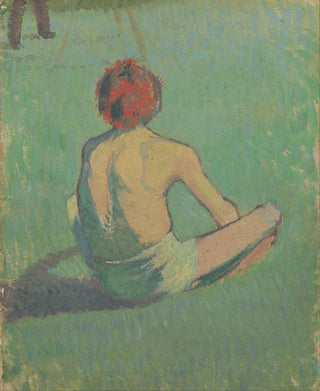Art print Boy sitting in the grass - Émile Bernard | Art print


View from behind

Frame (optional)
In the vibrant world of post-impressionist art, the piece "Garçon assis dans l'herbe" by Émile Bernard stands out for its brightness and apparent simplicity. This artwork, which evokes gentle intimacy, transports us to a world where nature and humanity coexist harmoniously. The young boy, frozen in a moment of contemplation, seems to invite the viewer to share his state of mind, to feel the warmth of the sun and the coolness of the grass beneath his feet. The art print of this piece allows appreciation of the delicacy and emotional depth emanating from each brushstroke, thus revealing the artist's soul.
Style and uniqueness of the work
Émile Bernard's style is characterized by a constant search for balance between abstraction and figuration. In "Garçon assis dans l'herbe," this duality is expressed through vibrant colors and simplified forms that capture the essence of the subject without altering reality. The chosen palette, dominated by greens and yellows, evokes natural light, while the delicate outlines of the boy blend harmoniously into the surrounding landscape. This piece is a perfect example of how Bernard manages to infuse a spiritual dimension into scenes of everyday life. The relaxed posture of the boy and his thoughtful gaze create an atmosphere of serenity, offering the viewer a contemplative pause.
The artist and his influence
Émile Bernard, an emblematic figure of the post-impressionist movement, established himself through his innovative approach to color and composition. A student of Paul Gauguin, he played a key role in the evolution of modern art, influencing many contemporary artists. His ability to fuse elements of traditional painting with new ideas paved the way for movements such as Fauvism and Cubism. Bernard always sought to express the beauty of life through simple themes, like capturing a fleeting moment in nature. "Garçon assis dans l'herbe" reflects this quest, illustrating his desire to explore human emotions through compositions that are both accessible and

Matte finish

View from behind

Frame (optional)
In the vibrant world of post-impressionist art, the piece "Garçon assis dans l'herbe" by Émile Bernard stands out for its brightness and apparent simplicity. This artwork, which evokes gentle intimacy, transports us to a world where nature and humanity coexist harmoniously. The young boy, frozen in a moment of contemplation, seems to invite the viewer to share his state of mind, to feel the warmth of the sun and the coolness of the grass beneath his feet. The art print of this piece allows appreciation of the delicacy and emotional depth emanating from each brushstroke, thus revealing the artist's soul.
Style and uniqueness of the work
Émile Bernard's style is characterized by a constant search for balance between abstraction and figuration. In "Garçon assis dans l'herbe," this duality is expressed through vibrant colors and simplified forms that capture the essence of the subject without altering reality. The chosen palette, dominated by greens and yellows, evokes natural light, while the delicate outlines of the boy blend harmoniously into the surrounding landscape. This piece is a perfect example of how Bernard manages to infuse a spiritual dimension into scenes of everyday life. The relaxed posture of the boy and his thoughtful gaze create an atmosphere of serenity, offering the viewer a contemplative pause.
The artist and his influence
Émile Bernard, an emblematic figure of the post-impressionist movement, established himself through his innovative approach to color and composition. A student of Paul Gauguin, he played a key role in the evolution of modern art, influencing many contemporary artists. His ability to fuse elements of traditional painting with new ideas paved the way for movements such as Fauvism and Cubism. Bernard always sought to express the beauty of life through simple themes, like capturing a fleeting moment in nature. "Garçon assis dans l'herbe" reflects this quest, illustrating his desire to explore human emotions through compositions that are both accessible and
12,34 €






